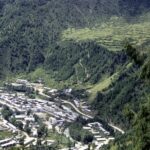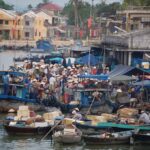Lhasa, Tibet
The autumn of 1987 found me in Tibet. Arriving by plane from Chengdu, I acclimatised in Lhasa for a few weeks and then travelled to the Chumbi valley in search of signs of the Younghusband’s 1903-1904 expedition to Lhasa. The signs were there – battle scarred forts, defensive walls and the telegraph system that once linked Younghusband with London. Entering through the Chumbi valley, Younghusband fought a battle in the shadow of Mt Chomolari (below); besieged the fortress at Gyanste (below) and marched triumphantly into Lhasa (see below) on 3 August 1904.
I arrived back in Lhasa just in time to witness the demonstrations against the Chinese that took place on 1 October 1987. As far I could establish, eight Tibetans were shot and killed during the demonstrations and a further twenty-three were wounded.
Lhasa is the capital city of the Tibet Autonomous Region in the People’s Republic of China. Here are some key aspects of Lhasa:
Geography: Lhasa is situated in the Himalayas at an altitude of approximately 3,656 meters (11,995 feet) above sea level. It is located on the Lhasa River’s northern bank, a Yarlung Tsangpo River tributary.
Historical and Cultural Significance: Lhasa has a rich history and is considered the traditional seat of the Dalai Lama, the spiritual leader of Tibetan Buddhism. The city has numerous historic sites, including the Potala Palace, Jokhang Temple, and Norbulingka, which are important cultural and religious landmarks.
Potala Palace: Perhaps the most iconic structure in Lhasa, the Potala Palace is a UNESCO World Heritage Site. It was the winter residence of the Dalai Lamas and served as the political and religious center of Tibet. The palace is perched on Marpo Ri (Red Hill) and offers panoramic views of the city.
Jokhang Temple: Located in the heart of Lhasa, Jokhang Temple is another UNESCO World Heritage Site. It is considered one of the holiest sites in Tibetan Buddhism and houses the Jowo Rinpoche, a revered statue of Buddha.
Barkhor Street: This is a bustling market area surrounding the Jokhang Temple. It is a popular pilgrimage circuit and market where locals and tourists alike can buy traditional Tibetan goods, religious artifacts, and handicrafts.
Norbulingka: Known as the “Jewel Park,” Norbulingka is a summer palace that served as the Dalai Lama’s traditional retreat. It features beautiful architecture, carefully tended gardens, and is also a UNESCO World Heritage Site.
Tibetan Buddhism: Lhasa is a significant center for Tibetan Buddhism, and the city’s religious and cultural heritage is closely tied to the traditions of this faith. The city sees pilgrims from all over Tibet and other parts of the world.
Modern Development: In recent years, Lhasa has undergone significant development and urbanization. Infrastructure projects, including transportation networks, have been implemented to improve connectivity with other parts of China.
Tourism: Lhasa attracts tourists and pilgrims from around the world who come to experience its unique culture, religious sites, and the stunning Himalayan landscape.
Challenges: Lhasa faces challenges related to its high-altitude location, environmental concerns, and issues related to cultural preservation amid modernization efforts.






Leave a comment